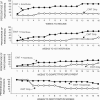The impact of enhanced incentives on vocational rehabilitation outcomes for dually diagnosed veterans
- PMID: 16270845
- PMCID: PMC1226169
- DOI: 10.1901/jaba.2005.100-03
The impact of enhanced incentives on vocational rehabilitation outcomes for dually diagnosed veterans
Abstract
This study evaluated the efficacy of adding contingency management techniques to vocational rehabilitation (VR) to improve treatment outcome as measured by entry into competitive employment. Nineteen dually diagnosed veterans who entered VR in the Veterans' Administration's compensated work therapy (CWT) program were randomly assigned to CWT (n = 8) or to CWT with enhanced incentives (n = 11). Over the first 16 weeks of rehabilitation, those in the incentives condition could earn up to dollar 1,006 in cash for meeting two sets of clinical goals: (a) remaining abstinent from drugs and alcohol and (b) taking steps to obtain and maintain a competitive job. Results indicate that relative to participants in the CWT-only group, those in the incentives condition engaged in more job-search activities, were more likely to remain abstinent from drugs and alcohol, were more likely to obtain competitive employment, and earned an average of 68% more in wages. These results suggest that rehabilitation outcomes may be enhanced by restructuring traditional work-for-pay contingencies to include direct financial rewards for meeting clinical goals.
Figures
References
-
- Acierno R, Donohue B, Kogan E. Psychological interventions for drug abuse: A critique and summation of controlled studies. Clinical Psychology Review. 1994;14:417–442.
-
- Bickel W.K, Amass L, Higgins S.T, Badger G.J, Esch R. Effects of adding behavioral treatment to opioid detoxification with buprenorphine. Journal of Consulting and Clinical Psychology. 1997;65:803–810. - PubMed
-
- Blow F.C, Gillon L, Dornfeld M. Comprehensive national evaluation of VHA compensated work therapy. Ann Arbor, MI: Serious Mental Illness Treatment Research and Evaluation Center; 2001.
-
- Bond G.R, Becker D.R, Drake R.E, Vogler K.M. A fidelity scale for the individual placement and support model of supported employment. Rehabilitation Counseling Bulletin. 1997;40:265–284.
-
- Budney A.J, Higgins S.T. A community reinforcement approach: Treating cocaine addiction. 2000. Retrieved October 14, 2004, from http://www.drugabuse.gov/TXManuals/CRA/CRA1a.html.
Publication types
MeSH terms
LinkOut - more resources
Full Text Sources
Medical


